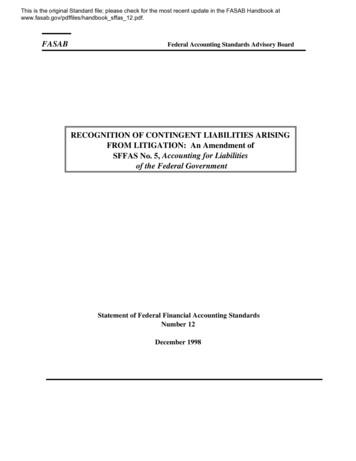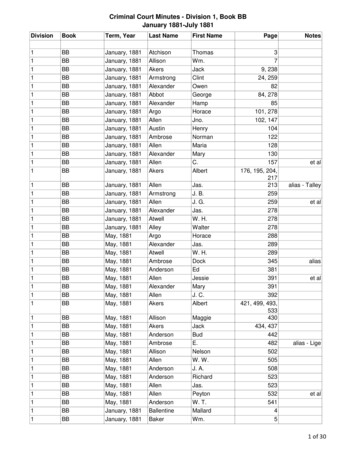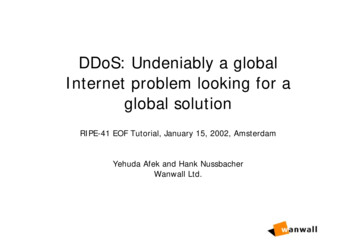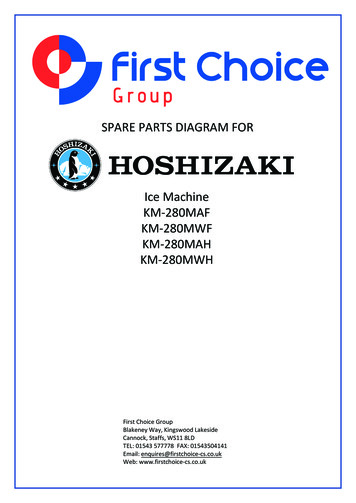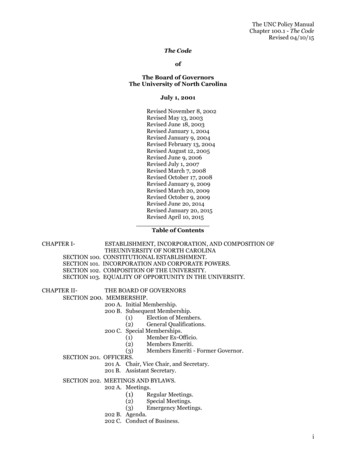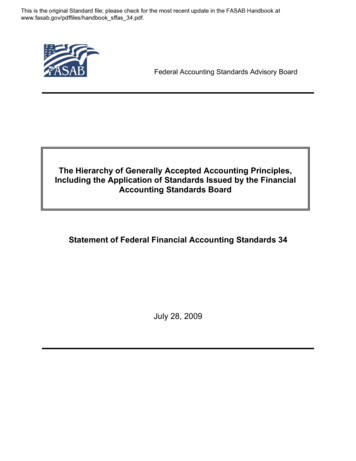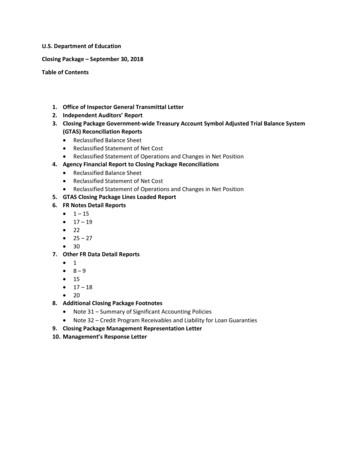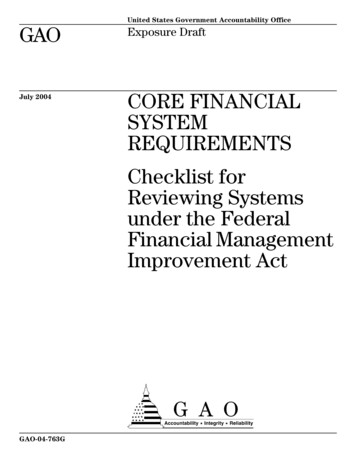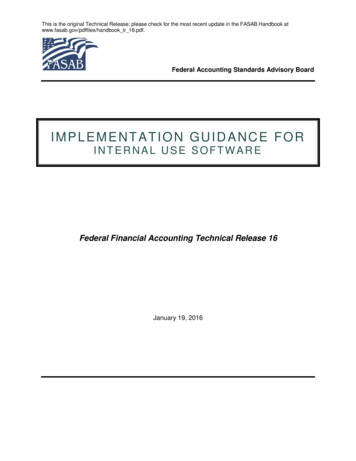
Transcription
Federal Accounting Standards Advisory BoardAugust 14, 2013MemorandumTo:Members of the BoardFrom:Monica R. Valentine, Assistant DirectorThrough: Wendy M. Payne, Executive DirectorSubject: Leases Project – Tab B1MEETING OBJECTIVESTo review the lease definition and scope issues currently being addressed by GASB inthe context of the federal environment.BRIEFING MATERIAL Staff Memoo FASAB Staff Analysis and Board Questions on the Leases Project Attachments –I.GASB Staff Issue Papers on Lease ProjectII.Excerpts from FASB s Revised ED on LeasesBACKGROUNDThe Lease project is being undertaken by the Board primarily because the current leaseaccounting standards, SFFAS 5 and 6, have been criticized as ineffective because theydo not make meaningful distinctions between capital and operating leases regarding thesubstance of lease transactions. In addition, the lease accounting standards in SFFAS 5and 6 are based on Financial Accounting Standards Board (FASB) lease accountingstandards which are currently being revised. The FASB and International AccountingStandards Board (IASB) have undertaken a joint project on lease accounting that1The staff prepares Board meeting materials to facilitate discussion of issues at the Board meeting. This material ispresented for discussion purposes only; it is not intended to reflect authoritative views of the FASAB or its staff. Officialpositions of the FASAB are determined only after extensive due process and deliberations.441 G Street NW, Mailstop 6K17V, Washington, DC 20548 (202) 512-7350 fax 202 512-7366
Tab B – Leases Project Staff Memofocuses on the conveyance of rights to future economic benefits (such as the right ofuse).In May 2013 the FASB released a revised exposure draft (ED) on Leases. Since therelease of the FASB ED, the Governmental Accounting Standards Board (GASB) hasbegun Board discussions to reexamine issues associated with lease accounting andconsider improvements to existing guidance. FASAB staff is currently working with theGASB staff to coordinate our efforts where applicable to develop new lease accountingstandards.The primary objective for this meeting‘s discussion is to consider the lease definitionand scope issues currently being addressed by GASB.Member feedback on the information presented will direct staff on the next steps to takein the project.Tab B – Leases Project Page 2
Tab B – Leases Project Staff AnalysisStaff Analysis and Questions for Board Consideration on theFASAB Leases ProjectNote: Staff suggests reading the attached GASB issue papers (Attachment I)before considering the below FASAB staff analysis and Board questionsbecause the GASB issue papers are the basis for our analysis and questions.GASB ISSUE 22, PAPER 1: Scope of the Lease project – GASB Question 1: What topics should be consideredwithin the scope of the Leases project? The GASB project staff recommended thatthe Leases project consider all topics currently in the GASB’s lease literature(Category 1) and one other relevant topic about which there currently is not GASBguidance (SCA-like situations from Category 3).GASB has tentatively agreed to address the following topics in its leases project: Scope and definition of a lease Classification of leases Fiscal funding or cancellation clauses Accounting and reporting by lessees, including disclosures Accounting and reporting by lessors, including disclosures Leases involving real estate Leases between state and local governments and public authorities Leases between related parties Sale-leaseback transactions Sale-leaseback transactions involving real estate Accounting and reporting for subleases and similar transactions Accounting and reporting for leveraged leases Service Concession Agreement (SCA)-like agreementsThe current FASAB standards on Leases are outlined in SFFAS 5 & 6. SFFAS 5, Accounting for Liabilities of the Federal GovernmentCapital leases are leases that transfer substantially all the benefits andrisks of ownership to the lessee. If, at its inception, a lease meets one or2Note that GASB numbers issues addressed at each meeting. The FASAB equivalent would be ―projects.‖ So, ―Issue 2‖references ―leases‖ which was the second topic addressed at the August GASB meeting. Also, GASB may provide multiplepapers to facilitate discussion of different aspects of a single issue. In this case, ―PAPER 1‖ addresses scope matters and―PAPER 2‖ addresses definitional matters.Tab B – Leases Project Page 3
Tab B – Leases Project Staff Analysismore of the following four criteria, the lease should be classified as acapital lease by the lessee: The lease transfers ownership of the property to the lessee by the end ofthe lease term. The lease contains an option to purchase the leased property at abargain price. The lease term is equal to or greater than 75 percent of the estimatedeconomic life of the leased property. The present value of rental and other minimum lease payments,excluding that portion of the payments representing executory cost, equalsor exceeds 90 percent of the fair value of the leased property.The last two criteria are not applicable when the beginning of the leaseterm falls within the last 25 percent of the total estimated economic life ofthe leased property. If a lease does not meet at least one of the abovecriteria it should be classified as an operating lease. (paragraph 43)The amount to be recorded by the lessee as a liability under a capitallease is the present value of the rental and other minimum leasepayments during the lease term, excluding that portion of the paymentsrepresenting executory cost to be paid by the lessor. [footnote 20: ―Thecost of general property, plant, and equipment acquired under a capitallease shall be equal to the amount recognized as a liability for the capitallease at its inception. [See SFFAS No. 6, Accounting for Property, Plant,and Equipment.] However, if the amount so determined exceeds the fairvalue of the leased property at the inception of the lease, the amountrecorded as the liability should be the fair value. If the portion of theminimum lease payments representing executory cost is not determinablefrom the lease provisions, the amount should be estimated. (paragraph44)The discount rate to be used in determining the present value of theminimum lease payments ordinarily would be the lessee‘s incrementalborrowing rate unless (1) it is practicable for the lessee to learn the implicitrate computed by the lessor and (2) the implicit rate computed by thelessor is less than the lessee‘s incremental borrowing rate. If both theseconditions are met, the lessee shall use the implicit rate. The lessee‘sincremental borrowing rate shall be the Treasury borrowing rate forsecurities of similar maturity to the term of the lease. (paragraph 45)During the lease term, each minimum lease payment should be allocatedbetween a reduction of the obligation and interest expense so as toproduce a constant periodic rate of interest on the remaining balance ofthe liability. [footnote21: OMB Circular No. A-11, ―Preparation andSubmission of Annual Budget Estimates,‖ explains the measurement ofbudget authority, outlays, and debt for the budget in the case of lease-Tab B – Leases Project Page 4
Tab B – Leases Project Staff Analysispurchases and other capital leases. Circular A-94, ―Guidelines andDiscount Rates for Benefit-Cost Analysis of Federal Programs,‖ providesthe requirements under which a lease-purchase or other capital lease hasto be justified and the analytical methods that need to be followed.](paragraph 46) SFFAS 6, Accounting for Property, Plant, and Equipment (PP&E)Capital leases are leases that transfer substantially all the benefits andrisks of ownership to the lessee. If, at its inception, a lease meets one ormore of the following four criteria, [footnote 7: Note that the criteria foridentifying capital leases for financial reporting purposes differ from OMBcriteria for budget scoring of leases. OMB Circular No. A-11, Preparationand Submission of Budget Estimates, includes criteria for identifyingoperating leases in Appendix B. OMB provides four additional criteriawhich relate to the level of private sector risk involved in a lease-purchaseagreement. This is necessary because, for budget purposes, there is adistinction between lease-purchases with more or less risk. This distinctionis not made in the financial reports and, therefore, FASAB does notinclude the four criteria related to risk levels.] the lease should beclassified as a capital lease by the lessee. Otherwise, it should beclassified as an operating lease. [footnote 8: ―Operating leases‖ of PP&Eare leases in which the Federal entity does not assume the risks ofownership of the PP&E. Multi-year service contracts and multi-yearpurchase contracts for expendable commodities are not capital leases.] The lease transfers ownership of the property to the lessee by the end ofthe lease term. The lease contains an option to purchase the leased property at abargain price. The lease term is equal to or greater than 75 percent of the estimatedeconomic life [footnote 9: ―Estimated economic life of leased property‖ isthe estimated remaining period during which the property is expected tobe economically usable by one or more users, with normal repairs andmaintenance, for the purpose for which it was intended at the inception ofthe lease, without limitation by the lease term.] of the leased property. The present value of rental and other minimum lease payments,excluding that portion of the payments representing executory cost, equalsor exceeds 90 percent of the fair value [footnote 10: ―Fair value‖ is the pricefor which an asset could be bought or sold in an arm‘s-length transactionbetween unrelated parties (e.g., between a willing buyer and a willingseller). (adapted from Kohler‘s Dictionary for Accountants)] of the leasedproperty.The last two criteria are not applicable when the beginning of the leaseterm falls within the last 25 percent of the total estimated economic life ofthe leased property. (paragraph 20)Tab B – Leases Project Page 5
Tab B – Leases Project Staff AnalysisThe cost of general PP&E acquired under a capital lease shall be equalto the amount recognized as a liability for the capital lease at its inception(i.e., the net present value of the lease payments calculated as specifiedin the liability standard [footnote 21: See Statement of RecommendedAccounting Standards No. 5, Accounting for Liabilities of the FederalGovernment.] unless the net present value exceeds the fair value of theasset). (paragraph 29) Staff AnalysisThe current FASAB guidance on leases is minimal and is in need of improvement.Revised lease standards are necessary to fully address the various leasetransactions/activities currently being used in the federal community.Question 1: What topics should be considered within the scope of the FASAB leasesproject?Staff RecommendationStaff recommends that all of the topics tentatively agreed to be addressed by GASB(listed above) should also be addressed in the FASAB project, with the followingqualifications. GASB has tentatively agreed to address ―Leases between state and localgovernments and public authorities,‖ since this topic is not applicable to the federalsector staff recommends revising this topic to ―Leases between federal entities.‖ Also,more research is necessary to determine the extent of sale-leaseback, leveraged lease,and SCA-like transactions within the federal community. Staff also recommends addingenhanced use leases3 to the project‘s scope.If the Board agrees with staff, we would continue our research on the tentatively agreedtopics and identify any other areas for scope inclusion or exclusionGASB ISSUE 2, PAPER 2: Definition of a Lease – “Agreement” vs. “Contract” – GASB Question 1: Shouldthe term “contract” be used instead of “agreement” in the definition of a lease? TheGASB project staff recommended the term “contract” over “agreement” because“contract” emphasizes the legal enforceability of the lease terms and conditions and“agreement” can be an informal arrangement between parties.The FASB ED on Leases proposes the following definition for lease – A contract thatconveys the right to use an asset (the underlying asset) for a period of time in exchangefor consideration.3Enhanced Use Lease – Typically a long-term agreement with public and private entities for the use of federalproperty, resulting in cash and/or in-kind consideration for the agency—or to retain the proceeds from the sale of realproperty. (Federal Real Property: Authorities and Actions Regarding Enhanced Use Leases and Sale of UnneededReal Property -- GAO-09-283R, 02/17/2009)Tab B – Leases Project Page 6
Tab B – Leases Project Staff AnalysisGASB’s current lease definition -- An agreement conveying the right to use capitalassets (land and/or depreciable assets) usually for a stated period of time. GASB hastentatively agreed to modify its lease definition by changing from ―agreement‖ to―contract.‖The current FASAB standards do not have a definition of lease; however ―capital lease‖and ―operating lease‖ are both defined in SFFAS 6. ―Capital leases are leases thattransfer substantially all the benefits and risks of ownership to the lessee. Operatingleases of PP&E are leases in which the Federal entity does not assume the risks ofownership of the PP&E. Multi-year service contracts and multi-year purchase contractsfor expendable commodities are not capital leases.‖ (SFFAS 6, paragraph 20) Staff AnalysisIn the federal environment, the term ―contract‖ could narrow the scope of leasingactivities applicable under the standard. There are instances when a federal leasearrangement may not contain all of the elements of a contract (i.e., an offer, acceptanceof the offer, consideration, and intent to be legally enforceable/bound). For example,legal enforceability may not always be a clear element with federal lease arrangements.Question 2: Should the term ―contract‖ or ―agreement‖ be used in the FASAB definitionof a lease?Staff RecommendationStaff recommends that the FASAB definition of lease use the term ―agreement‖ asopposed to ―contract‖ because using ―contract‖ could narrow the scope of the leasestandards and not capture all leasing transactions involving federal entities. Definition of a Lease – “Asset” vs. “Capital Asset/Property, Plant &Equipment” – GASB Question 2: Should the term “asset (the underlying asset)” beused instead of “capital assets (land and/or depreciable assets)” in the definition of alease? The GASB project staff recommends replacing the term ― “capital assets(land and/or depreciable assets)” with the term ― “asset (the underlying asset)” inthe definition of a lease in the existing GASB Standards. One reason given is thescope of an asset is broader and more inclusive than capital asset.In GASB Concepts Statement No. 4, Elements of Financial Statements, paragraph 8,assets are defined as ― ―resources with present service capacity that the governmentpresently controls.‖ GASB has tentatively agreed to use ―asset (the underlying asset)‖ inits definition of lease.In FASAB SFFAC 5: Definitions of Elements and Basic Recognition Criteria for AccrualBasis Financial Statements defines an asset as – ―a resource that embodies economicbenefits or services that the federal government controls.‖In FASAB SFFAS 6, property, plant, and equipment (PP&E) consists of tangible assets,including land, that meet the following criteria: they have estimated useful lives of 2 years or more; they are not intended for sale in the ordinary course of operations; andTab B – Leases Project Page 7
Tab B – Leases Project Staff Analysis they have been acquired or constructed with the intention of being used, or beingavailable for use by the entity. Staff AnalysisAlthough many federal leasing activities involve PP&E, the scope of the leasingstandard should not be limited to only PP&E assets. PP&E assets are limited to tangibleassets. Also, the three criteria for PP&E would further narrow the scope of the leasestandard.Question 3: Should the term ―asset‖ or ―property, plant, & equipment‖ be used in theFASAB definition of a lease?Staff RecommendationStaff agrees with GASB tentative decision to use the broader term ―asset‖ as opposedto ―property, plant, & equipment‖ which could narrow ―leases‖ in a way that leads tosimilar activities being excluded from coverage of the standards. Staff believesnarrowing should be accomplished through specific exclusions (the approach taken bythe FASB and IASB) as they are likely to be clearer to the reader. Definition of a Lease – Addition of “in Exchange for Consideration” -- GASBQuestion 3: Should the phrase “in exchange for consideration” be added to thedefinition of a lease? GASB project staff believes that the phrase ― “in an exchangeor exchange-like transaction” should be added to the definition instead of ― “inexchange for consideration.”GASB Statement No. 33, Accounting and Financial Reporting for NonexchangeTransactions, defines an exchange-like transaction as – ―one in which the valuesexchanged, though related, may not be quite equal or in which the direct benefits maynot be exclusively for the parties to the transactions. Nevertheless, the exchangecharacteristics of the transaction are strong enough to justify treating the transaction asan exchange for accounting recognition.‖ GASB staff believes that using ―in exchangefor consideration‖ alone would exclude both nonexchange and exchange-liketransactions from the scope of the lease standards. Additional, they noted thatnonexchange lease transactions will be adequately addressed in GASB Statement no.33. GASB has tentatively agreed to add the phrase ― ―in an exchange or exchange-liketransaction‖ to the lease definition.Current FASAB standards define exchange and nonexchange transactions, but do notinclude a definition of ―exchange-like transactions.‖ The FASAB terms are defined inSFFAS 5, paragraphs 22 & 24 – ―an exchange transaction arises when each party tothe transaction sacrifices value and receives value in return. There is a two-way flow ofresources or of promises to provide resources. A nonexchange transaction ariseswhen one party to a transaction receives value without directly giving or promising valuein return. There is a one-way flow of resources or promises.‖FASAB has also addressed the distinction between exchange and nonexcahngetransactions in the context of revenue. SFFAS 7, Accounting for Revenue and OtherTab B – Leases Project Page 8
Tab B – Leases Project Staff AnalysisFinancing Sources, states that “an exchange transaction occurs when one partysacrifices value and receives a valuable good or service in return.‖ It further providesthat ―nonexchange revenues arise primarily from exercise of the Government‘s power todemand payments from the public, such as taxes, duties, fines, and penalties.‖ SFFAS7 also established disclosure requirements regarding exchange revenue. Federalentities are required to disclose instances when pricing policies for programs withexchange revenue require prices that are not based on either full cost or market value.The GASB literature specifies that in an exchange each party receives and gives upessentially equal values. In contrast, the FASAB standards do not address whether theexchange is of essentially equal values. In both SFFAS 5 and 7, the standards provideguidance to classify specific transactions. For this reason, staff believes it is reasonableto assume exchange-like transactions as defined by GASB are classified as exchangetransactions by federal entities. Staff AnalysisSince current FASAB standards do not use the term ―exchange-like transactions‖ wewill not specifically address the question in the same manner as GASB. However, theFASAB needs to address whether ―a lease‖ arises in nonexchange transactions. Forexample, should an agreement through which a host government (e.g., another nationor a state government) provides use of a facility free of charge for a period of timequalify as a lease? The accounting consequence would be potential recognition of theright of use of the facility as an asset and the gift of the use as a ―revenue‖ (or deferredrevenue). Given that an asset is a resource that embodies economic benefits orservices that the federal government controls, a key question is whether ―control‖ isestablished through a nonexchange transaction. Assuming it can be, the Board maywish to consider whether the matter should be addressed in standards for ―leases‖ orthrough standards tailored to such nonexchange transactions (the GASB approach).Staff needs to do additional research to determine the extent of nonexchange or―exchange-like‖ leasing transactions within the federal government. If our researchshows that nonexchange and ―exchange-like‖ leasing transactions are prevalent in thefederal environment and not addressed in current FASAB guidance, staff wouldconsider the facts and make the appropriate recommendations concerning thoseleasing transactions.Question 4: Should staff assess the prevalence of nonexchange and ―exchange-like‖leasing transactions and whether ―control‖ of a resource is generally conveyed in suchtransactions in the federal environment?Staff RecommendationStaff recommends that we make this assessment. While we believe ―exchange-like‖transactions are generally included in ―exchange transactions‖ under the current federalstandards, we should confirm this. In addition, we are aware that there are agreementsallowing use of facilities for nominal ( 1) or even no fees we do not know the extent towhich these are used.Tab B – Leases Project Page 9
Tab B – Leases Project Staff Analysis Notions Supporting the Definition of a Lease – Explanatory Guidance -- GASBQuestion 4: Should the explanatory guidance be included in the text of the standard?GASB project staff does not believe that the explanatory guidance should beincluded in the text of the standard.Immediately following the definition of a lease FASB‗s ED provides further explanatoryguidance to assist in determining if an arrangement is a lease.At inception of a contract, an entity shall determine whether that contract is orcontains a lease by assessing both of the following:a. Whether fulfillment of the contract depends on the use of an identified asset.b. Whether the contract conveys the right to control the use of the identified assetfor a period of time in exchange for consideration.The GASB project staff believes that this type of explanation is better suited forimplementation guidance rather than text of a standard. Staff AnalysisStaff believes that this question should be deferred until the proposed lease standardsare further developed. We believe that it is premature to decide whether thisexplanatory language is appropriate. Two key differences between GASB and FASABmay lead us to a different conclusion – FASAB establishes standards for a singlereporting entity so more detailed guidance at the standards level may be cost-effectiveand FASAB does not publish a comprehensive implementation guide as is GASB‘spractice so timely guidance (as an illustration or within the standards) may be helpful.Question 5: Should the question concerning the explanatory guidance to assist indetermining if an arrangement is a lease included in the FASB ED be deferred until theFASAB lease standards are further developed?Staff RecommendationStaff recommends that this question be deferred until the proposed lease standards arefurther developed. Scope of Standards – Inclusions -- GASB Question 5: Should the current inclusioncontinue for the agreements that are not called lease but are in-substance leases?The GASB project staff believes that contracts that are not identified as leases butmeet the definition of a lease should continue to be included in the lease literature.GASB Question 6: Should a heat supply contract continue to be included as anexample of a lease that is within the scope of the lease literature? The GASB projectstaff believes the example of a heat supply contract should be removed from thelease literature.FASB Statement 13, paragraph 1, states that a lease: ― ―includes agreements that,although not nominally identified as leases, meet the above definition, such as a ‗heatsupply contract‘ for nuclear fuel.‖ It is also states that ― ―agreements that do transferTab B – Leases Project Page 10
Tab B – Leases Project Staff Analysisthe right to use property, plant, or equipment meet the definition of a lease for purposesof this Statement even though substantial services by the contractor (lessor) may becalled for in connection with the operation or maintenance of such assets.”The GASB project staff recommended that for the purpose of defining a lease, it isnecessary to continue to include agreements that meet the definition of a lease, but arenot self-described as leases. The GASB project staff believes that the nature of thoseagreements reflects the substance of a lease, which is to transfer the right to use theunderlying asset. GASB has tentatively decided that the current inclusion continue forthe agreements that are not called leases but are in-substance leases.The GASB project staff does not believe it is appropriate to continue to include theexample of a heat supply contract, as this specific contract has very limited applicabilityin the government environment. The example of a heat supply contract was included inGASB Statement 62 because it was written in FASB Statement 13. GASB hastentatively agreed with its staff‘s recommendation to remove the specific ―heat supplycontract‖ example from the scope section of the lease standard. Staff AnalysisStaff agrees with GASB‘s tentative decision that the current inclusion continue for theagreements that may not be called leases but are in-substance leases for the samereasons noted above by the GASB staff – if the nature of the agreements reflect thesubstance of a lease, they should be included within the scope of the lease standards.For example, GSA intra-governmental leases are referred to as ―occupancyagreements.‖Staff is not currently aware of the applicability of ―heat supply contracts‖ in the federalenvironment. Additional staff research is necessary to determine if federal entities areinvolved in ―heat supply contracts.‖ Therefore we believe this topic should be deferreduntil staff determines the applicability of these contracts in the federal environment.Question 6: Should the scope of FASAB lease standards include agreements thatreflect the substance of a lease even if they are not called a lease? Should FASABdefer the decision to include or exclude ―heat supply contracts‖ as an example in thelease standards?Staff RecommendationStaff recommends that the scope of FASAB lease standards include agreements thatreflect the substance of a lease even if they are not called a lease. Staff alsorecommends deferring the decision to include or exclude ―heat supply contracts‖ as anexample in the FASAB lease standards. Scope of Standards – Exclusions -- GASB Question 7: Should the currentexclusions continue for the scope of leases? The GASB project staff believes thatTab B – Leases Project Page 11
Tab B – Leases Project Staff Analysisscope exclusions, as discussed below, should continue to be consistent with thoseexcluded by the FASB.The GASB staff recommended that for the purpose of defining a lease, the currentexclusions existing in GASB Statement 62 should be continued, for the followingreasons: Agreements that are contracts for services that do not transfer the right to usecapital assets from one contracting party to the other do not meet the definition ofleases. Leases to explore for or use of minerals, oil, natural gas, and similarnonregenerative resources should be excluded, because of the complexity of thistopic. While many governments may be lessors in these types of arrangements,few are lessees. It would be difficult to explore accounting for these situationswithout a larger research effort into extractive activities. The FASB excludedthese arrangements from its proposal for these reasons. Licensing agreements for such items as motion picture films, video recordings,plays, manuscripts, patents, and copyrights should be excluded because theyare examples of intangible assets. The topic of intangible assets is complex, andwas addressed in GASB Statement 51. The FASB‗s proposal excluded intangibleassets from the scope in favor of reviewing all accounting issues related tointangibles in a separate project. The FASB‗s proposal removes references tothese specific types in favor of excluding intangible assets in general. Agreements that meet the definition of a service concession arrangement (SCA)should be excluded because the guidance on SCA were provided in GASBStatement 60. The IASB similarly scoped out SCAs because it has separateguidance for those arrangements, though the project staff notes that the IASB‗sdefinition of SCA is slightly different from the GASB‗s definition. Additionally, because of the complexity of the topics, the GASB staffrecommended that the following exclusions from the FASB‗s ED be added:o Leases of intangible assets.o Leases of biological assets, including timber.GASB has tentatively agreed to continue all existing GASB exclusions (contracts forservices, oil/gas/etc., licensing agreements, and service concession arrangements), addan exclusion for biological assets, but not exclude all intangibles (keep the status quowhere some are in scope and some are not). Staff AnalysisTab B – Leases Project Page 12
Tab B – Leases Project Staff Analysis Agreements that contract for services that do not transfer the right to use anasset from one contracting party to the other would not meet the basic premise ofa lease which transfers/conveys the right to use an asset. Federal natural resources is defined in Technical Bulletin (TB) 2011-1:Accounting for Fed
In addition, the lease accounting standards in SFFAS 5 and 6 are based on Financial Accounting Standards Board (FASB) lease accounting standards which are currently being revised. The FASB and International Accounting . Accounting and reporting for leveraged leases Service Concession Agreement (SCA)-like agreements .
